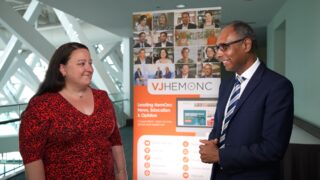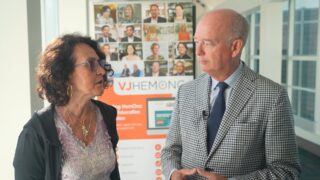Leif Bergsagel:
Hello, my name is Leif Bergsagel. I’m a hematologist at the Mayo Clinic, Arizona.
Charlotte Pawlyn:
Hi, my name is Charlotte Pawlyn. I’m a hematologist at the Institute of Cancer Research and the Royal Marsden Hospital in London.
Leif Bergsagel:
And we’re here at iwMyeloma 25. And Charlotte, let’s just review what we heard in that last session dealing with drug resistance...
Leif Bergsagel:
Hello, my name is Leif Bergsagel. I’m a hematologist at the Mayo Clinic, Arizona.
Charlotte Pawlyn:
Hi, my name is Charlotte Pawlyn. I’m a hematologist at the Institute of Cancer Research and the Royal Marsden Hospital in London.
Leif Bergsagel:
And we’re here at iwMyeloma 25. And Charlotte, let’s just review what we heard in that last session dealing with drug resistance. I thought there were some interesting stories that emerged. We looked at resistance to lenalidomide and IMiDs in general, and we talked about resistance to T-cell therapies and resistance to daratumumab. And it seemed like one theme was that a loss of some cell specificity or change in cell identity seemed to be an underlying theme as a mechanism of resistance to all of those. What did you think?
Charlotte Pawlyn:
Yeah, I thought that was really interesting. I guess we think of mechanisms of resistance as being to do with loss of the target or the focus of that particular agent. But some of, as you say, some of the work you beautifully presented was about different cell identity or transcriptional change that kind of helps to support that resistant clone evolving.
Leif Bergsagel:
Yeah, now of course, there are obviously mutations of the target and you’ve done some beautiful work looking at the mutations of the IMiD receptors and target genes. And there was some new stuff about CD38. Interestingly, about 20% of patients relapsing have lost the target.
Charlotte Pawlyn:
Yeah, I found that really interesting. I feel like we’ve heard a lot recently about mutations of the target of the anti-BCMA, anti-GPRC5D binding bispecific antibodies. Perhaps that’s maybe triggered people to go back and look at the CD38 itself as a mechanism for daratumumab resistance, which I personally wasn’t aware of having been done previously, although we’ve been using daratumumab for many years in the clinic. So, really interesting that that’s a common mechanism with the bispecific cell surface targets too. And particularly interesting, I think, in common with the changes we’ve seen in BCMA and how that may not be specific to every agent that targets that cell surface protein. The same seemed to be true of their CD38 mutations in that some were apparently more selective for one anti-CD38 agent over the other. And I’m sure the same is true vice versa. It just depends which agent you’ve been exposed to first, perhaps, that you generate resistance. But I guess I wonder what you take from that in terms of clinical implementation, whether we should switch between the agents or move to a different target.
Leif Bergsagel:
Yeah. It seems like it’s not very common. So I think empirically switching may not necessarily be the best approach. And generally, I think maybe moving to a different, we have so many to choose from now, moving to a different choice. And then I guess Niels Weinhold presented very interesting data about another sort of mechanism of resistance. And he took biopsies from the same patient at different places, at diagnosis or before treatment, and then again at relapse and showed very different patterns of progression where clearly there are multiple subclones that could be selected for outgrowth over time. I really enjoyed that presentation.
Charlotte Pawlyn:
Yeah, I found this really fascinating, but at the same time really challenging to worry about how we’re going to stay one step ahead of all of the different changes that can happen in different sites within a patient, how we can make sure that we’re trying to outsmart the tumor in all of those different places. I thought particularly interesting was the work I’d not seen before that he presented where they’d taken one lesion, paramedullary lesion, and sampled multiple different sites of the same macroscopic tumor. So I can sort of understand how you can have so many differences in lesions that are far away anatomically, perhaps due to immune-driven differences. But within one single lesion, I guess I would have expected them to be more similar than he presented.
Leif Bergsagel
I was really surprised by that data. I hadn’t seen that. And finally, you actually changed the title of your talk. You talked about sort of a way of overcoming IMiD resistance. Do you want to talk about that?
Leif Bergsagel:
Yeah, so we’ve been working on the combination of EZH2 inhibition and IMiDs and CELMoDs in the lab for the last few years and find synergy between EZH2 inhibition. So, tazemetostat, which is an FDA-approved EZH2 inhibitor for lymphomas, seems to work very well with the IMiDs and CELMoDs in the laboratory, at least in our hands. And I think that the mechanism of that, we’ve been kind of trying to find our way towards what’s driving that. And I think it is probably similar to some of the mechanisms that you’ve been looking at in terms of thinking of the control of the IRF4 gene locus as being a super enhancer space where we’re kind of focused on all of the different components of the super enhancer and how that can control IRF4 expression, which is really so critical to plasma cell identity and persistence. And I think we have some evidence that we can see changes within the super enhancer after EZH2 inhibition as well, and that seems to fit with some of the other work around looking at super enhancer changes.
Leif Bergsagel:
Yeah. Well, I think that’s a wonderful summary of the session and thank you for your attention.
This transcript is AI-generated. While we strive for accuracy, please verify this copy with the video.



















